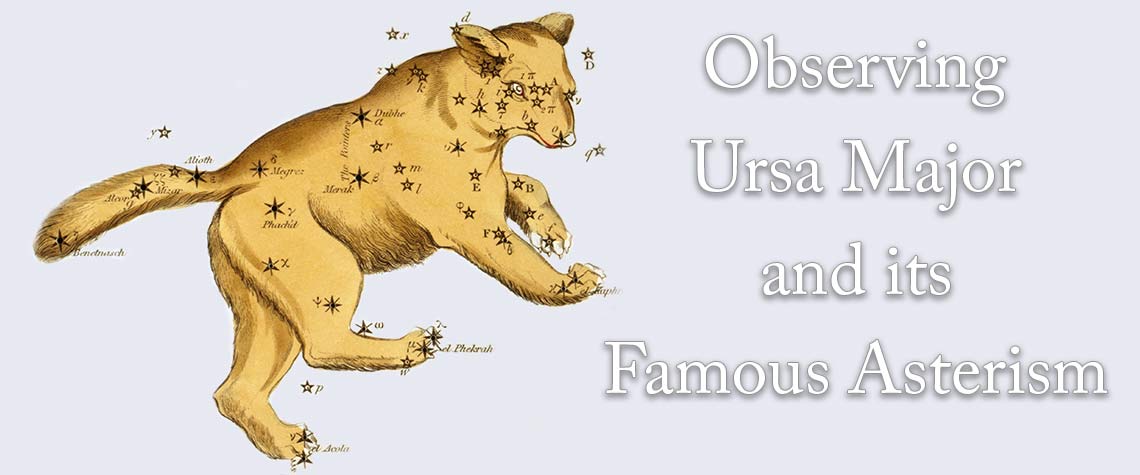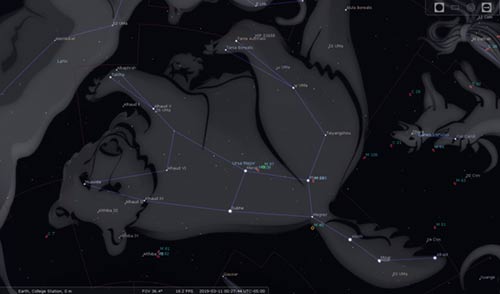Page 2


Eye on the Sky - Ursa Major
By Tom Campbell
Ursa Major is one of the oldest constellations in our night sky. It is also home to one of the most well-known and most easily recognizable asterisms, the Big Dipper.
The seven stars of the Big Dipper have a wide variety of meanings in different cultures. To the ancient Romans, the seven stars represented the Seven Ploughing Oxen; the Babylonians saw them as a wagon; Northwest Europe saw them as a plough; Egyptians saw them as the Bull's Hind Leg; the Sioux Indians saw them as the Skunk; to the Hebrews they represented a Bushel; the Caucasians saw them as the Sickle and in North Africa, they were seen as the Camel.
Despite this wide variety, a lot of cultures saw this group of stars as a bear, including the ancient Greeks, the Iroquois Indians, and even the Chinese. The Iroquois may have the most interesting legend, however.
According to the Iroquois, only the four bowl stars represent a bear. An arc of naked-eye stars (including Arcturus) represent seven bear hunters, each named after a different bird. The stars we think of as the dipper's handle were representative of Robin, Chickadee and Moose Bird. Chickadee (Mizar) carried a cooking pot (Alcor) to cook the bear in after they killed him. The other hunters were Pigeon, Blue Jay, Owl (Arcturus), and Saw-Whet.
In the Spring, the bear leaves his den (Corona Borealis) and the long hunt begins. As Summer comes to an end, the four farthest hunters disappear below the horizon and give up on the hunt. In Autumn, the bear stands up on his hind legs as it rises in the northeast and Robin finally shoots it with an arrow. The bear shakes itself, trying to dislodge the arrow, and flings blood everywhere, which is why the trees turn red in Autumn. A streak of blood also lands on Robin's chest, which is how the robin got its name Redbreast. Finally, as Winter comes, the hunt is complete and the hunters cook the bear and feed their families while the bear's skeleton remains in the sky with its feet pointed upwards. When next Spring arrives, the bear den is visible and the hunt starts again.
Mizar is the middle star of the handle of the Big Dipper. If you look closely in moderately dark skies, you might be able to pick out a fainter star right next to it. This is Alcor. In Arabian mythology, Mizar is a horse and Alcor is its rider. In Greek mythology, Alcor is the lost Pleiad, Electra.
Using a telescope, you will notice that Mizar is itself a double star. As a matter of fact, both members of the Mizar system are spectroscopic binaries, making it a quadruple star system. Alcor is also believed to be spectroscopic binary and has the same proper motion through the sky as Mizar.
Messier 40 was discovered in 1764 by Charles Messier. Johannes Hevelius had reported a nebula in this area, but not seeing anything else, Messier recorded this pair of stars instead. In 2001, data gathered by amateur astronomers Brian Skiff and Richard Nugent suggested that this was actually an optical double and the stars were not gravitationally bound. The GAIA satellite took measurements in 2016 and found this to indeed be the case. One star is twice as far away from Earth as the other.
Although Messier entered Messier 81 in his catalog in 1779, it was actually discovered five years earlier by Johann Elert Bode and thus has the nickname of Bode's Galaxy. This spiral galaxy is about 90,000 light years across, putting it at about half the diameter of the Milky Way.
Messier 82 is close to Messier 81, both physically and as seen from Earth. In fact, at low magnification, both galaxies will easily fit into the same field of view. Its unusual shape and orientation have earned it the nickname of the Cigar Galaxy. Tidal forces from M 81 have distorted the shape of the galaxy and caused star formation to increase at a rate about 10 times what is seen in a normal galaxy.
Messier 97 was discovered in 1781 by Pierre Méchain. When William Parsons, the Third Earl of Rosse, observed it in 1848, his sketch resembled an owl's head. Ever since, it has had the nickname of the Owl Nebula. This object is actually a planetary nebula, meaning that it was formed by a star shedding its outer layers of gas. The central white dwarf star isn't easily observable in amateur instruments.
Known as the Pinwheel Galaxy due to its large face-on spiral, Messier 101 can be difficult to see in light-polluted skies. This is because of its large size and low surface brightness. From a dark rural site, however, it can be seen even in a pair of binoculars. The galaxy is about 170,000 light years across and contains an estimated one trillion stars.
Although Messier 108 is a barred spiral galaxy, it is facing at a sharp angle to us and appears as a thin oval. Amateur astronomers have given it the nickname of the Surfboard Galaxy.
At a distance of over 83 million light years, Messier 109 has the distinction of being the farthest object listed in the Messier Catalog. My only observation of it was back in 2002, using an 8" dob from my rural back yard: "This is an extremely faint and fairly large galaxy. The middle is somewhat brighter, but not stellar. No details are visible, but it does appear elongated."
| Object | Type | Mag(s) | Dist. (ly) | R. A. | Dec. |
|---|---|---|---|---|---|
| Mizar & Alcor | Multiple Star | 2.0, 4.0 | 83 | 13h 23.9m | +54° 56' |
| M 40 (Winnecke 4) | Optical Double Star | 9.7, 10.1 | 509 | 12h 22.2m | +58° 05' |
| M 81 (Bode's Galaxy) | Spiral Galaxy | 6.9 | 11,808,000 | 09h 55.6m | +69° 04' |
| M 82 (Cigar) | Irregular Galaxy | 8.4 | 12,069,000 | 09h 55.9m | +69° 41' |
| M 97 (Owl) | Planetary Nebula | 9.9 | 2,026 | 11h 14.8m | +55° 01' |
| M 101 (Pinwheel) | Spiral Galaxy | 7.8 | 20,877,000 | 14h 03.2m | +54° 21' |
| M 108 (Surfboard) | Barred Spiral Galaxy | 10.7 | 45,994,000 | 11h 11.5m | +55° 40' |
| M 109 (Vacuum Cleaner) | Barred Spiral Galaxy | 10.6 | 83,507,000 | 11h 57.6m | +53° 22' |
